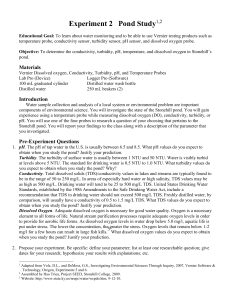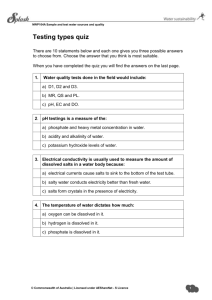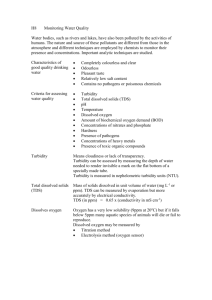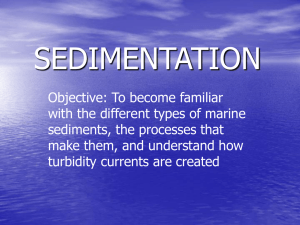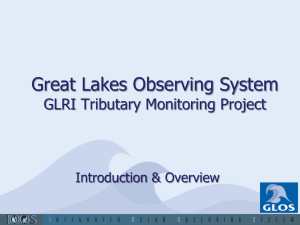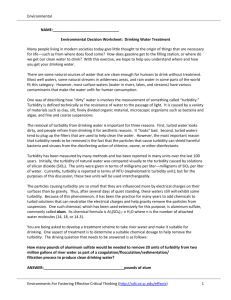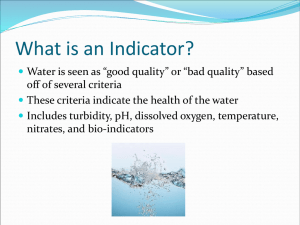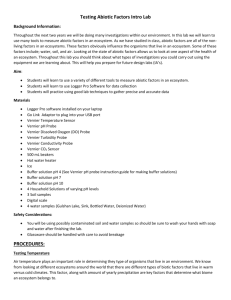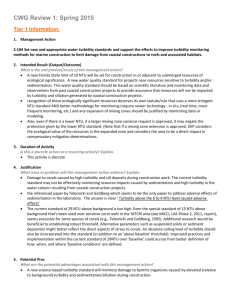Water Quality Lab: Preliminary Activity & WQI Tests
advertisement
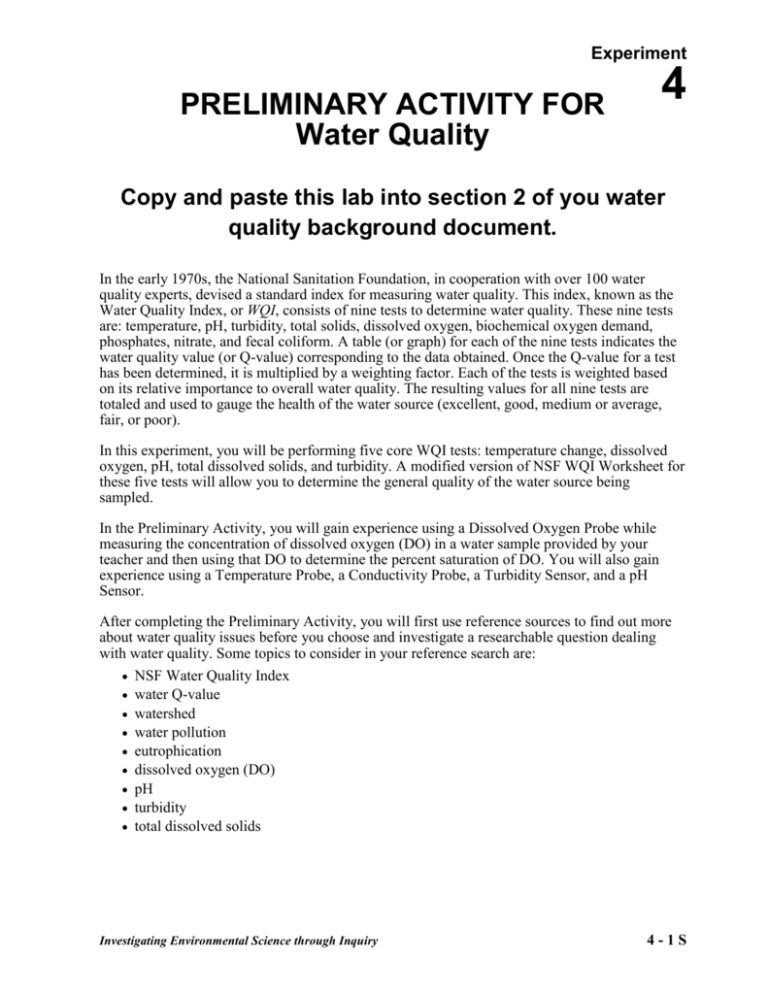
Experiment 4 PRELIMINARY ACTIVITY FOR Water Quality Copy and paste this lab into section 2 of you water quality background document. In the early 1970s, the National Sanitation Foundation, in cooperation with over 100 water quality experts, devised a standard index for measuring water quality. This index, known as the Water Quality Index, or WQI, consists of nine tests to determine water quality. These nine tests are: temperature, pH, turbidity, total solids, dissolved oxygen, biochemical oxygen demand, phosphates, nitrate, and fecal coliform. A table (or graph) for each of the nine tests indicates the water quality value (or Q-value) corresponding to the data obtained. Once the Q-value for a test has been determined, it is multiplied by a weighting factor. Each of the tests is weighted based on its relative importance to overall water quality. The resulting values for all nine tests are totaled and used to gauge the health of the water source (excellent, good, medium or average, fair, or poor). In this experiment, you will be performing five core WQI tests: temperature change, dissolved oxygen, pH, total dissolved solids, and turbidity. A modified version of NSF WQI Worksheet for these five tests will allow you to determine the general quality of the water source being sampled. In the Preliminary Activity, you will gain experience using a Dissolved Oxygen Probe while measuring the concentration of dissolved oxygen (DO) in a water sample provided by your teacher and then using that DO to determine the percent saturation of DO. You will also gain experience using a Temperature Probe, a Conductivity Probe, a Turbidity Sensor, and a pH Sensor. After completing the Preliminary Activity, you will first use reference sources to find out more about water quality issues before you choose and investigate a researchable question dealing with water quality. Some topics to consider in your reference search are: NSF Water Quality Index water Q-value watershed water pollution eutrophication dissolved oxygen (DO) pH turbidity total dissolved solids Investigating Environmental Science through Inquiry 4-1S Experiment 4 PROCEDURE STATION 1: DISSOLVED OXYGEN AND TEMPERATURE 1. Connect the Dissolved Oxygen Probe to the interface and start the data-collection program. Allow the probe to stay in distilled water for at least 5 minutes as the probe warms up. 2. Collect DO data. a. Place the tip of the probe into the water sample being tested. Submerge the probe tip to a depth of 4–6 cm. b. Start data collection. Gently stir the probe in the water sample. Note: It is important to keep stirring until you have finished collecting data. c. Continue stirring and data collection until the readings have been relatively stable (stable to the nearest 0.2 mg/L) for about 30 seconds, then stop data collection. d. Select the stable region of your graph, then display Statistics for that region. Note and record the mean value for that region as the DO of the water sample (in mg/L). 3. Measure and record the temperature of the water sample. Record the value (in ºC). 4. Determine the percent saturation of DO for the water sample using your DO value from Step 2, the temperature you measured in Step 3, Tables 4 and 5 provided by your teacher, and the formula % saturation = (actual DO reading / Saturated DO reading from Table 4) X 100 STATION 2: CONDUCTIVITY AND PH 5. Use a Conductivity Probe to obtain the total dissolved solid (TDS) value for the water sample. Have the switch on the Conductivity Probe box set to 0–2000 µS/cm (2000 µS/cm = 1000 mg/L TDS). Record the value (in mg/L). 6. Use a pH Sensor to measure the pH of the water sample. Record the value. STATION 3: TURBIDITY (IF AVAILABLE) 7. Collect turbidity data. a. Connect a Turbidity Sensor to the interface. Allow the powered Turbidity Sensor to warm up for five minutes. b. Calibrate the sensor or manually enter calibration values following instructions from your teacher. c. Obtain a portion of slightly turbid water from your teacher. Fill your turbidity cuvette until the bottom of the meniscus is exactly at the top of the line on the cuvette. This sample level is critical to obtaining correct turbidity values. d. Measure the turbidity of the water sample. Record the value (in NTU). 4-2S Investigating Environmental Science through Inquiry Water Quality QUESTIONS 1. What was the DO of the water sample you tested in the Preliminary Activity? What was its % saturation (show calculations)? 2. Thermal pollution occurs when heated water produced during certain industrial processes is released into waterways. Identify possible thermal pollution problems in your area? 3. Water with a pH of 7 is considered neutral. If the pH is below 7, it is classified as acidic, while water with a pH greater than 7 is said to be alkaline. The pH of tap water in the U.S. is usually between 6.5 and 8.5. What was the pH of the water you tested in the Preliminary Activity? What pH values do you expect to obtain when you study local waters? Justify your prediction. 4. The turbidity of surface water is usually between 1 NTU and 50 NTU. Water is visibly turbid at levels above 5 NTU. The standard for drinking water is 0.5 NTU to 1.0 NTU. What turbidity values do you expect to obtain when you study local waters? Justify your prediction. 5. TDS values in lakes and streams are typically found to be in the range of 50 to 250 mg/L. In areas of especially hard water or high salinity, TDS values may be as high as 500 mg/L. Drinking water will tend to be 25 to 500 mg/L TDS. United States Drinking Water Standards, established by the 1986 Amendments to the Safe Drinking Water Act, include a recommendation that TDS in drinking water should not exceed 500 mg/L TDS. Freshly distilled water, by comparison, will usually have a conductivity of 0.5 to 1.5 mg/L TDS. What TDS values do you expect to obtain when you study local waters? Justify your prediction. 6. Identify creeks, streams, rivers, lakes, reservoirs, wetlands, and estuaries in your area that might be studied in this experiment. 7. Point source pollution is discharged into the environment through pipes, sewers, or ditches from specific sites such as factories or sewage treatment plants. List possible point source pollution sites in your area that might influence the WQI of the affected body of water. 8. List at least one researchable question for this experiment and write it here and on the board. Investigating Environmental Science through Inquiry 4-3S
